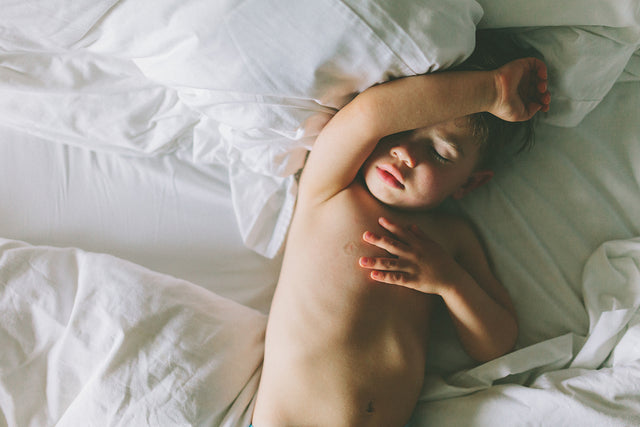The Scoop on Restless Sleep Disorder in Kids

Nighttime disturbances that steal precious zzz’s can be seriously, well, disturbing. And parents are right to be concerned about their tot’s tossing and turning. Quality of sleep impacts every part of our lives! Poor sleep can trigger to irritability, impaired coordination, behavior issues, lack of focus, poor memory, and even increased injury risk. Plus, good quality sleep supports healthy brain development!
Recently, doctors have begun to put together an official diagnosis for children for what’s called restless sleep disorder, which describes frequent and persistent restlessness at night. Here’s what parents need to know.
What is restless sleep disorder in kids?
Restless sleep disorder (RSD) is a newly recognized problem in children 6-18 years of age. It was described in a recent issue of the respected medical journal, Sleep Medicine. As you might guess from its name, RSD is defined by restlessness during sleep that leads to exhausted, bleary-eyed kiddos in the morning.
RSD is similar to restless leg disorder in the way that there are physical movements that are disturbing sleep. However, the symptoms of restless leg disorder (an uncomfortable sensation in the legs, twitching, or the urge to move) can be experienced during the day too. And restless sleep disorder is broader in that it’s defined by big body movements… which could be legs, arms, torso etc.
What are symptoms of restless sleep disorder in kids?
The primary symptom of restless sleep disorder are major body movements during sleep…that might look like kicking, thrashing, or flailing. But restless sleep disorder isn’t just one or two nights of tossing and turning. It’s diagnosed when a child experiences these major body movements at least three times a week for at least three months and is resulting in “significant impairment” during the day.
Because you probably don’t have eyes on your child all night, the first thing that might tip you off to a potential sleep disorder is that your kid continually wakes up exhausted and unrested...despite appearing to get enough hours of sleep. They might seem foggy, clumsy, or cranky.
When should parents talk to a doctor about restless sleep disorder?
While the official diagnosis requires three months of restless sleep, you may want to reach out to your care provider as soon as you notice these nighttime disturbances are affecting your child’s mood, behavior, or ability to function during the day. Even if your doctor can’t give you a restless sleep disorder diagnosis, they may be able to provide tips or a treatment plan to help your child sleep better.
How is restless sleep disorder treated?
There’s some evidence that links restless sleep to iron deficiency. So, iron supplements are often prescribed to treat restless sleep disorders. Of course, speak with your provider before giving your child an iron supplement, but by all means, don’t wait to load up your kid’s plate with iron-rich foods, like meats, legumes (lentils, beans, etc.!).
There are a few other simple changes you can make to help improve quality of sleep for your child:
- Stick to a regular nap and nighttime schedule. Being short on sleep can contribute to a variety of sleep issues.
- Use a predictable, calming bedtime routine every night. To get your child in a relaxed state of mind, an hour before bed, dim the lights and turn on white noise.
- Use low, rumbly white noise, which can help mask outside disturbances.
- Try to avoid stimulants (like chocolate, caffeinated drinks, antihistamines, or decongestants), which can lead to restlessness.
- In that golden hour before bedtime, reduce rough-housing and screen time.
- Try bedtime sweet talk as part of your routine to help relax your child’s mind. Here’s how you do this little tip: As you tuck in your tyke, talk about all the wonderful things that happened that day, and mention how your lovebug’s brain can be so calm that they’ll probably sleep very well.